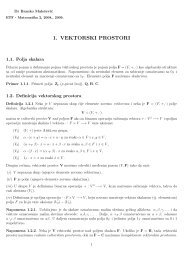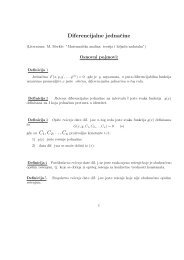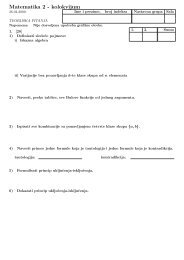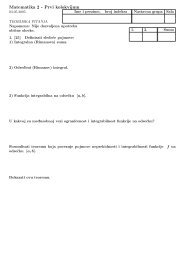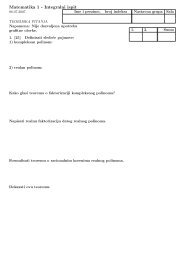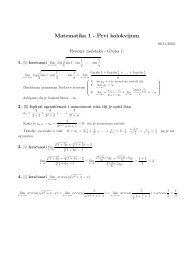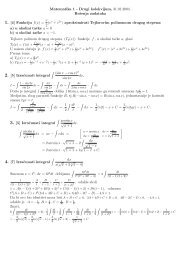PROBLEM SECTION - Matematika
PROBLEM SECTION - Matematika
PROBLEM SECTION - Matematika
Create successful ePaper yourself
Turn your PDF publications into a flip-book with our unique Google optimized e-Paper software.
Univ. Beograd. Publ. Elektrotehn. Fak.Ser. Mat. 16 (2005), 146–155.Available electronically at http: //pefmath.etf.bg.ac.yu<strong>PROBLEM</strong> <strong>SECTION</strong>Edited by Nenad P. CakićWe publish research problems in all areas of Mathematics that fall in one of thefollowing categories:a) Research problems or conjectures with a solution not known to the proposer. Theseproblems are marked with an asterisk after their number.b) Research problems seeking a new, more elegant solutionc) Inquiries about references and state of the art regarding a particular problem.Problems should be submitted in a form that is easy to understand to a nonspecialistin a field. If using special terms or notations can not be avoided, they should be defined ina statement of a problem. A problem may be accompanied by a short comment (addressedprimarily to specialists) that explains why the solution could be of an interest.Solutions should be worked out in all reasonable details.Correspondence regarding Problem Section should be sent to:Nenad Cakić, Faculty of Electrical Engineering, University of Belgrade,P. O. Box 35-54, 11120 Belgrade, Serbia and Montenegro.cakic@kondor.etf.bg.ac.yu• Problem 63 ∗ proposed by Mihály Bencze, Brasov, Romania.If Sn p ∑=n k p and R p ∑n = n ( n)k p , where n, p ∈ N, thenk=1k=1kn∏ ( n kp( ) Rp Spn≤ n.k)For example,k=1k=1n∏ ( n k4( 15 (n≤k) 2 + 5n − 2) · 2 n−3 ) n (n + 1)(2n + 1)(3n2 + 3n − 1)30(2n + 1)(3n 2 .+ 3n − 1)S p nThis is a generalisation of the Problem 62.146
148 Problem Sectionwhere p is a prim number and e base of the natural logarithm.Reference1. R. K. Guy: Unsolved problems in number theory. 2nd. ed., 1994, Springer Verlag.• Problem 69 ∗ proposed by Mirko Jovanović, Belgrade, Serbia and Montenegro.Let x n = f(n) (n ∈ N). Determine sufficient conditions for f, such that allpoints in a fixed closed interval [a, b] (0 < b − a < +∞), are accumulation pointsof {x n }.• Problem 70 ∗ proposed by Slavko Simić, Belgrade, Serbia and Montenegro.Prove the following inequality:sinh x · cosh yx(√ ) x2> cosh3 + y2(x ≠ 0).Solutions• Problem 50 proposed by Slavko Simić and Vladimir Janković, Belgrade,Serbia and Montenegro.If real numbers a, b, c satisfy: a) a + b + c = 2, b) bc + ca + ab ≥ abc + 1,then the inequality(ax + by + cz) 2 ≥ 4 ( (1 − a) yz + (1 − b) zx + (1 − c) xy )holds for each real x, y, z.Solution by Li Zhou, Winter Haven, USA.Firstly,D = (ax + by + cz) 2 − 4 ( (1 − a)yz + (1 − b)zx + (1 − c)xy )Now= a 2 x 2 + b 2 y 2 + c 2 z 2 − 2 (2 − 2c − ab)xy − 2 (2 − 2a − bc)yz − 2 (2 − 2b − ca)zx.a 2 = 4 − (2 + a)(2 − a) = 4 − (2 + a)(b + c) = (2 − 2c − ab) + (2 − 2b − ca),and similarlyThusb 2 = (2 − 2a − bc) + (2 − 2c − ab) and c 2 = (2 − 2b − ca) + (2 − 2a − bc).D = (2 − 2c − ab)(x − y) 2 + (2 − 2a − bc)(y − z) 2 + (2 − 2b − ca)(z − x) 2 .
Problem Section 149Splitting (z − x) 2 as((x − y) + (y − z)) 2= (x − y) 2 + 2 (x − y)(y − z) + (y − z) 2 ,we getFinally,D = a 2 (x − y) 2 + c 2 (y − z) 2 + 2 (2 − 2b − ca)(x − y)(y − z)≥ 2 ( |ca| − |2 − 2b − ca| ) |x − y| |y − z|.ca = 2 − (a + b + c) + ca = (1 − b) + (1 − c)(1 − a),2 − 2b − ca = (1 − b) + (c + a − 1) − ca = (1 − b) − (1 − c)(1 − a).Hence, if 1 − b = 0 then |ca| − |2 − 2b − ca| = 0. Otherwise|ca| − |2 − 2b − ca|(∣ ∣ ∣)∣∣∣ (1 − b)(1 − c)(1 − a) ∣∣∣ = |1 − b| 1 +(1 − b) 2 −(1 − b)(1 − c)(1 − a) ∣∣∣∣1 −(1 − b) 2 ≥ 0,since (1 − b)(1 − c)(1 − a) = bc + ca + ab − abc − 1 ≥ 0.Also solved by Vladimir Janković.• Problem 51 proposed by Péter Ivády, Budapest, Hungary.(1)holds.Show that for x > 0,√ (1 − exp −x 2 ) √ (√ < tanh x < 3 1 − exp −x2 + 1x 3 )√x3 + 1Solution by the proposer.First we prove the left-hand side of (1). Using the inverse function of tanh x,we get the equivalent form(2)1 + 1 − exp12 ln √1 − 1 − exp√1 + 1 − exp12 ln √1 − 1 − exp(−(−x 2 )√x2 + 1x 2 ) < x.√x2 + 1Now, applying the mean-value theorem on [0, x] we find – after some computations√ (−x(−x 2 )√x2 + 1x 2 )√x2 + 1=η (η 2 + 2)2 (η 2 + 1) 3/2 √1 − exp(−η 2 ) ,√η2 + 1
150 Problem Sectionfor a suitable 0 < η < x. Now we will show that the right-hand side of (2) is forη > 0 less than 1, orη (η 2 + 2)2 (η 2 + 1) 3/2 √1 − exp(−η 2 ) < 1.√η2 + 1After squaring, simplifying, taking the logarithm, and using the substitution η 2 =t (t > 0) we may write(t− √ < ln 1 − 1 t (t + 2) 2 )t + 1 4 (t + 1) 3 ,which is equivalent to f(t) < 0, where(tf(t) = − √ − ln 1 − 1 t (t + 2) 2 )t + 1 4 (t + 1) 3 .Clearly(5) f(0) = 0.So it is enough to show that f ′ (t) < 0. Differentiation of f yields((t + 2) 3t 3 + 8t 2 + 2t (√ t + 1 + 4 ) − 4 √ )t + 1 + 4(6) f ′ (t) = −.(t + 1) 3/2 (6t 3 + 16t 2 + 16t + 8)Next we must show that the second term of the numerator in (6) is positive for allt > 0. Using the substitution √ t + 1 = u (u > 1), we have3u 6 − u 4 + 2u 3 + u 2 − 6u + 1 = (u − 1)(3u 5 + 3u 4 + 2u 3 + 4u 2 + 5u − 1) > 0.We conclude that from (6) follows f ′ (t) < 0, which was to be prove.By the similar procedure, we can obtain the right side of (1). Indeed, we getfirst the equivalent form√ (x1 +13 1 − exp −3 )√(7)2 ln x3 + 11 − 3 √1 − exp(−x 3 ) > x.√x3 + 1According to the mean-value theorem we get on [0, x]√ (x1 +13 1 − exp −3 )√(8)2x ln x3 + 1(x1 −√1 3 − exp −3 )√x3 + 1
=(2 (η 3 + 1)(1 3/2 − exp −Problem Section 151η 3√η3 + 1η 2 (η 3 + 2)) ) 2/3(1 −( (1 − exp −for some 0 < η < x. It is sufficient to prove that for all η > 0,(2 (η 3 + 1)(1 3/2 − exp −η 3√η3 + 1η 2 (η 3 + 2)) ) 2/3(1 −( (1 − exp −η 3 ) ) 2/3)√η3 + 1η 3 ) ) 2/3) > 1,√η3 + 1holds. Changing variable η to t > 0 we obtain from (1)(9)t 2 (t 3 (+ 2)(2 (t 3 + 1) > 1 − exp −3/2t 3 ) ) 2/3( ( (√ 1 − 1 − exp −t3 + 1t 3 ) ) 2/3)√ .t3 + 1Using t > 1 − e −t (t > 0), we can improve (9) as follows(10)t 2 (t 3 + 2)2 (t 3 + 1) > t 2 (1 −3/2 (t 3 + 1) 1/3t 2 )(t 3 + 1) 1/3(t > 0).But inequality (10) holds obviously, because for t > 0 we haveThis completes the proof of (1).t 3 + 22 (t 3 + 1) > 13/2 (t 3 + 1) . 1/3• Problem 52 proposed by Mihály Bencze, Brasov, Romania.Let be f : R → R a differentiable function such that(1) f ′ (x) + a f(x) = e −bx2for all x ∈ R and a, b > 0. Compute limx→∞ f(x).Solution by Milan Drešević, Belgrade, Serbia and Montenegro.It is easy to see thatf(x) = e −ax( x∫C +0)e −bt2 +at dt(C ∈ R)is general solution of the linear differential equation (1).Since Ce −ax → 0 (x → ∞), we have, by L’Hospital’s Rule,lim f(x) = limx→∞ x→∞x∫e −bt2 +at dt0e axe −bx2 +ax= limx→∞ a e ax = 1 a lim = 0.x→∞ e−bx2
152 Problem Sectionlimx→∞Also solved by proposer.Michael Bataille (Rouen, France) proved the following:More generaly, if f ′ (x) + af(x) = g(x), where g : R → R is continuous andg(x) = 0, then lim f(x) = 0.x→∞• Problem 53 proposed by Mihály Bencze, Brasov, Romania.The function f : R → R is integrable and 0 < α ≤ 1. Computelimn→+∞n∑k=1( kk −α f tgn)Solution by Li Zhou, Winter Haven, USA.∫Denote the limit as L(α). Then it is easy to see that L(1) = 1 f(x) tg xdx.0 xSuppose now that 0 < α < 1. Given any ε > 0, there exists an N such that ifn > N then1 < tg (kα /n)k α ≤ tg (nα−1 )/n n α−1 < 1 + εfor 1 ≤ k ≤ n. Hence for n > N,n∑( ( k∣ k −α f tgn)k=1( kαn( kαn)− 1 n f ( kn) )∣ ∣ ∣∣ < ε).n∑k=11(∣ k)∣ ∣∣.∣fn nSincewe conclude thatlimn∑n→+∞k=1L(α) =1nlim(∣ k ∣∣1∫∣f = |f(x)| dx < +∞,n)∣0n∑n→+∞k=11( k)n f =n1∫f(x) dx0for 0 < α < 1.Also solved by proposer.• Problem 54 proposed by Mihály Bencze, Brasov, Romania.Prove the inequality:∫π/20( sin xx) 2dx>11 π162 + 3881 .
Problem Section 153Solution by Slavko Simić, Belgrade, Serbia and Montenegro.Much better estimation can be obtained using the following:( sin x) 3For 0 < x < π/2 we have > cos x.x[cf. D. S. Mitrinović: Analytic Inequalities. Springer-Verlag, NY (1970), p. 238].Hence∫π/20( sin xx) 2∫π/2dx > x cos x ∫π/2sin x dx = − log sin x dx = π 200log 2.Sinceπ2 log 2 = 1.08879 . . . , 11π162 + 3881 = 0.68245 . . . ,our more precise assertion is approved.Also solved by Li Zhou (Winter Haven, USA), M. G. Radojević (G. Milanovac,Serbia and Montenegro) and the proposer.• Problem 55 proposed by Slavko Simić, Belgrade, Serbia and Montenegro.Prove that the following precise inequality holds for x ≥ 1/4 :( 12 x 2 1 ) (+ 6x + 1 −log60 x 2 + 2< 1 12 x 2 1 )+ 6x + 1 −12 x 2 1 x < log 60 x 2 + 1.− 6x + 1 −60 x 2 12 x+ 22 1− 6x + 1 −60 x 2 + 1Solution by Li Zhou, Winter Haven, USA.It is known as Lambert’s continued fraction [1] thattanh z =1 +3 +which is valid for all values of z. Hence for x > 0,6x1/2 x=12x 2 1+ 1 −60x 2 + 10(1/2 x)1 +2(1/2 x)27 3 +(1/2 x)25 +76x=.12x 2 1+ 1 −60x 2 + 1zz 2z 25 + z27 + · · ·( 1)1/2 x< tanh
154 Problem SectionNow let f(x) = 120x 3 + 12x − 60x 2 − 1. Then f(0.216) ≈ 0.002 > 0 and f ′ (x)= 12 ( 5x 2 + (5x − 1) 2) . Hence for x ≥ 0.216, f(x) > 0 and thusTherefore6x12x 2 1+ 1 −60x 2 + 1= 60x2 + 1120x 3 + 12x < 1.( 12x 2 1 ) ()+ 6x + 1 −60xlog2 + 10/7= 2 tanh −1 6x12x 2 1− 6x + 1 −12x 2 1+ 1 −60x 2 + 10/760x 2 + 10/7() (< 1 x < 6x12x 2 1 )+ 6x + 1 −tanh−1 60x= log2 + 112x 2 1+ 1 −12x 2 1− 6x + 1 −60x 2 + 160x 2 + 1for x ≥ 0.216.Reference1. H. S. Wall: Analytic Theory of Continued Fractions. AMS Chelsea Publishing, 2000,p. 349.Also solved by proposer.• Problem 58 proposed by Ó. Ciaurri Ramírez, Logroño, Spain and J. L.Díaz-Barrero, Barcelona, Spain.Let A = {a n } n≥0 be a sequence of real numbers. We define{ n∑}T 1 (A) = {Tn(A)} 1 n≥0 = n−k+1 a k ,k=0F{ n∑}R 1 (A) = {Rn(A)} 1 n≥0 =k=0(−2) n−k (k + 1) a k+1 ,and , for m > 1, T m (A) = T 1( T m−1 (A) ) and R m (A) = R 1( R m−1 (A) ) . Show thatT m (F) = 1 m! Rm (F),where F = {F n+1 } n≥0 and F n is the n th Fibonacci number defined by F 0 = 0,F 1 = 1 and for n ≥ 2, F n = F n−1 + F n−2 .Solution by Li Zhou, Winter Haven, USA.Let f(x) = ∑ F n+1 x n and g(x) = ∑n>0n≥0(−2x) n . Then f(x) =and g(x) =11 − x − x 211 + 2x . Let tm (x) = ∑ Tn m (F)x n and r m (x) = ∑ Rn m (F)x n . Byn≥0 n≥0
Problem Section 155definition, t 1 (x) = f(x) 2 , and by induction, t m (x) = f(x) m+1 for m > 1. Also,r 1 (x) = g(x)f ′ (x) and r m (x) = g(x) ( r m−1 (x) ) ′for m > 1. Sinceg(x)f ′ (x) =Assyme that t m−1 (x) =1(1 − x − x 2 ) 2 = f(x)2 , t 1 (x) = r 1 (x).1(m − 1)! rm−1 (x) for some m > 1. Thenr m (x) = g(x) ( (m − 1)! t m−1 (x) ) ′ 1 =1 + 2xm!=(1 − x − x 2 ) m+1 = m! tm (x).( (m − 1)!(1 − x − x 2 ) m ) ′Therefore, t m (x) = 1 m! rm (x) for all m ≥ 1, completing the proof.Also proved by proposers.


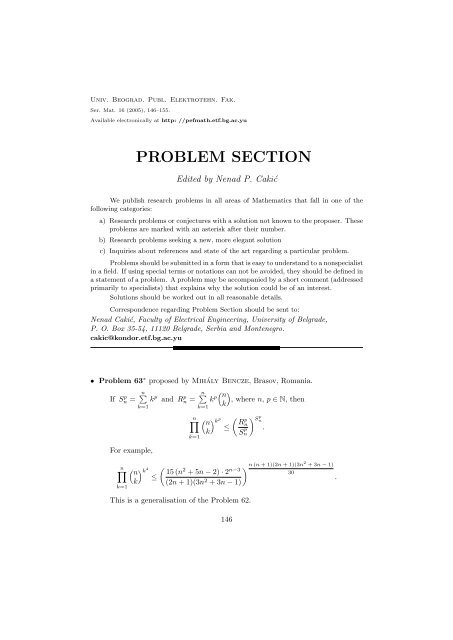
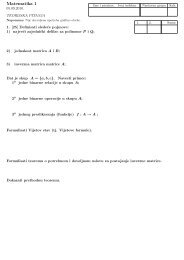
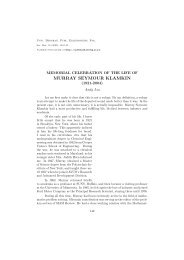
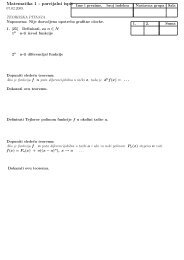

![Matematika 1 3. [7]](https://img.yumpu.com/49790285/1/184x260/matematika-1-3-7.jpg?quality=85)
